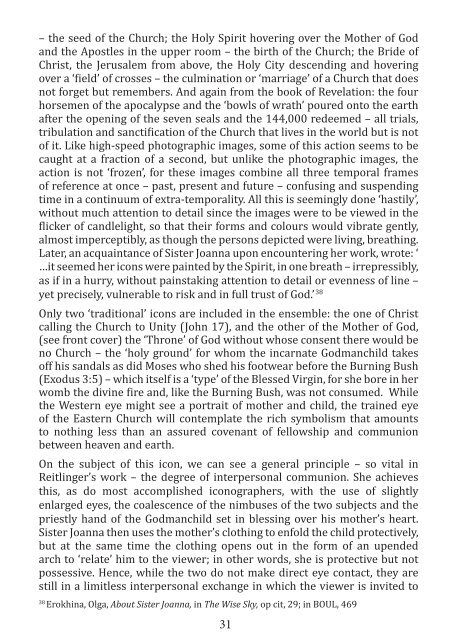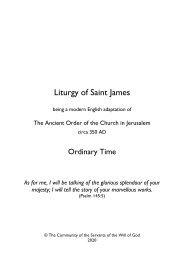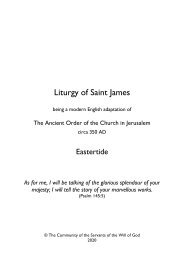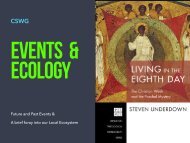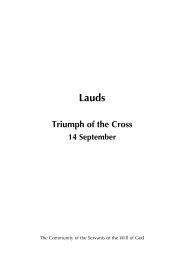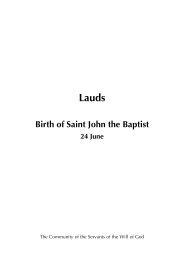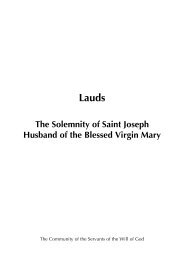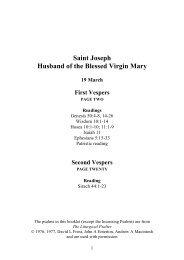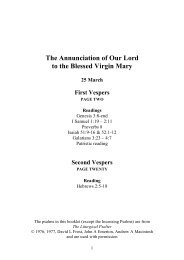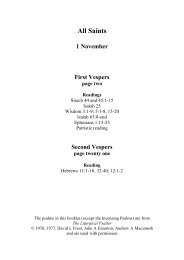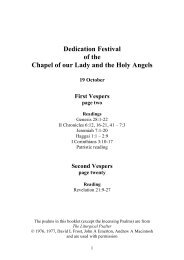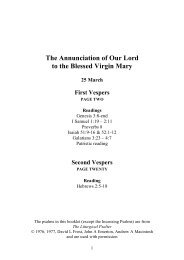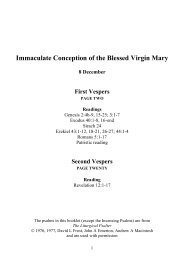In Praise of Holy Women
'Come to the Father' is the official journal of the Anglican Community of the Servants of the Will of God, Sussex, England, a contemplative monastic order for men and women founded in 1938. The aim of the journal is to maintain a dialogue between the Churches - East and West. This issue features articles on Evelyn Underhill, Julia DeBeausobre, Therese of Lisieux, Sister Joanna Reitlinger and Dorothy Day.
'Come to the Father' is the official journal of the Anglican Community of the Servants of the Will of God, Sussex, England, a contemplative monastic order for men and women founded in 1938. The aim of the journal is to maintain a dialogue between the Churches - East and West. This issue features articles on Evelyn Underhill, Julia DeBeausobre, Therese of Lisieux, Sister Joanna Reitlinger and Dorothy Day.
Create successful ePaper yourself
Turn your PDF publications into a flip-book with our unique Google optimized e-Paper software.
– the seed <strong>of</strong> the Church; the <strong>Holy</strong> Spirit hovering over the Mother <strong>of</strong> God<br />
and the Apostles in the upper room – the birth <strong>of</strong> the Church; the Bride <strong>of</strong><br />
Christ, the Jerusalem from above, the <strong>Holy</strong> City descending and hovering<br />
over a ‘field’ <strong>of</strong> crosses – the culmination or ‘marriage’ <strong>of</strong> a Church that does<br />
not forget but remembers. And again from the book <strong>of</strong> Revelation: the four<br />
horsemen <strong>of</strong> the apocalypse and the ‘bowls <strong>of</strong> wrath’ poured onto the earth<br />
after the opening <strong>of</strong> the seven seals and the 144,000 redeemed – all trials,<br />
tribulation and sanctification <strong>of</strong> the Church that lives in the world but is not<br />
<strong>of</strong> it. Like high-speed photographic images, some <strong>of</strong> this action seems to be<br />
caught at a fraction <strong>of</strong> a second, but unlike the photographic images, the<br />
action is not ‘frozen’, for these images combine all three temporal frames<br />
<strong>of</strong> reference at once – past, present and future – confusing and suspending<br />
time in a continuum <strong>of</strong> extra-temporality. All this is seemingly done ‘hastily’,<br />
without much attention to detail since the images were to be viewed in the<br />
flicker <strong>of</strong> candlelight, so that their forms and colours would vibrate gently,<br />
almost imperceptibly, as though the persons depicted were living, breathing.<br />
Later, an acquaintance <strong>of</strong> Sister Joanna upon encountering her work, wrote: ‘<br />
…it seemed her icons were painted by the Spirit, in one breath – irrepressibly,<br />
as if in a hurry, without painstaking attention to detail or evenness <strong>of</strong> line –<br />
yet precisely, vulnerable to risk and in full trust <strong>of</strong> God.’ 38<br />
Only two ‘traditional’ icons are included in the ensemble: the one <strong>of</strong> Christ<br />
calling the Church to Unity (John 17), and the other <strong>of</strong> the Mother <strong>of</strong> God,<br />
(see front cover) the ‘Throne’ <strong>of</strong> God without whose consent there would be<br />
no Church – the ‘holy ground’ for whom the incarnate Godmanchild takes<br />
<strong>of</strong>f his sandals as did Moses who shed his footwear before the Burning Bush<br />
(Exodus 3:5) – which itself is a ‘type’ <strong>of</strong> the Blessed Virgin, for she bore in her<br />
womb the divine fire and, like the Burning Bush, was not consumed. While<br />
the Western eye might see a portrait <strong>of</strong> mother and child, the trained eye<br />
<strong>of</strong> the Eastern Church will contemplate the rich symbolism that amounts<br />
to nothing less than an assured covenant <strong>of</strong> fellowship and communion<br />
between heaven and earth.<br />
On the subject <strong>of</strong> this icon, we can see a general principle – so vital in<br />
Reitlinger’s work – the degree <strong>of</strong> interpersonal communion. She achieves<br />
this, as do most accomplished iconographers, with the use <strong>of</strong> slightly<br />
enlarged eyes, the coalescence <strong>of</strong> the nimbuses <strong>of</strong> the two subjects and the<br />
priestly hand <strong>of</strong> the Godmanchild set in blessing over his mother’s heart.<br />
Sister Joanna then uses the mother’s clothing to enfold the child protectively,<br />
but at the same time the clothing opens out in the form <strong>of</strong> an upended<br />
arch to ‘relate’ him to the viewer; in other words, she is protective but not<br />
possessive. Hence, while the two do not make direct eye contact, they are<br />
still in a limitless interpersonal exchange in which the viewer is invited to<br />
38<br />
Erokhina, Olga, About Sister Joanna, in The Wise Sky, op cit, 29; in BOUL, 469<br />
31


